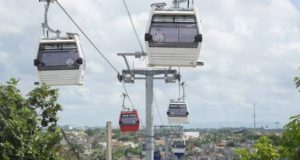
President Abinader was in Santiago to start construction of the city’s modern transportation system, the Integrated Transportation System of Santiago (SITS). SITS calls for the construction of a cable car, monorail, OMSA electric buses and bicycle lanes.
President Abinader said the cable car will have the capacity to transport 4,500 passengers per hour on a route of more than 6 km in two sections. The cable car is planned to transport more than 72,000 passengers every day.
The Santiago Cable Car will run from the La Yaguita del Pastor sector to the Central Las Carreras Terminal in Pueblo Nuevo, a distance of 3.21 km with four stops. It will also cover the UASD sector of Santiago in La Barranquita to the Pekin neighborhood, a distance of 3.31 km and three stops.
Abinader stressed that the government is investing in collective transport because the cost of commuting is one of the greatest costs in the everyday budget of Dominican households, representing close to 30% of the family budget of the poor.
“According to data provided by the Ibero-American Observatory of Road Safety in Latin America, and published by the World Bank, in the region there are an average of 230 vehicles per thousand inhabitants, but in the Dominican Republic there are more than 300 vehicles per thousand inhabitants,” he said. The President says that these figures are evidence of the need for new collective solutions to the problems of transportation, mobility, accessibility in the cities and the reduction of CO2 environmental emissions.
The Santiago Cable Car will be developed by the Unidad Ejecutora de Readecuación de Barrios y Entornos (URBE), in coordination with the Office for the Development of Urban and Interurban Mobility Projects of the Ministry of the Presidency.
Engineer Jhael Isa, director of the Urban and Interurban Mobility Project Development Office, explained that the Santiago Cable Car will fly over the most congested areas of the city at the Hermanos Patiño Bridge and the Ercilia Pepín Bridge, giving access to the slum areas near the banks of the Yaque del Norte River. Urban renewal projects will also be carried out in these areas.
Santiago Mayor Abel Martinez, Senator Eduardo Estrella; the director of URBE, Miguel González Cuadra; Industry and Commerce Minister Víctor (Ito) Bisonó; the governor of Santiago; Rosa Santos and Ulises Rodríguez, director of Pro Industria were present.
The President says the government has available RD$42 billion for Santiago province as part of the 2020-2025 comprehensive development plan.
Read more in Spanish:
Presidency
N Digital
30 September 2021

